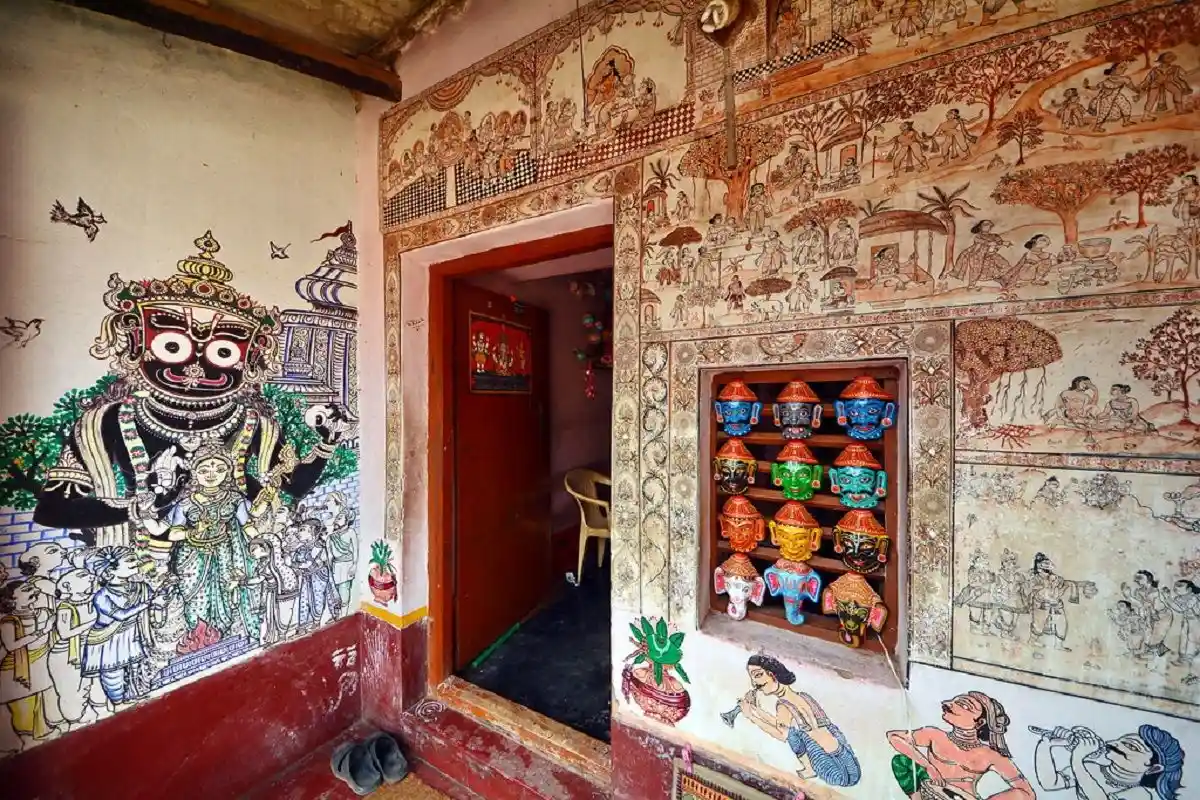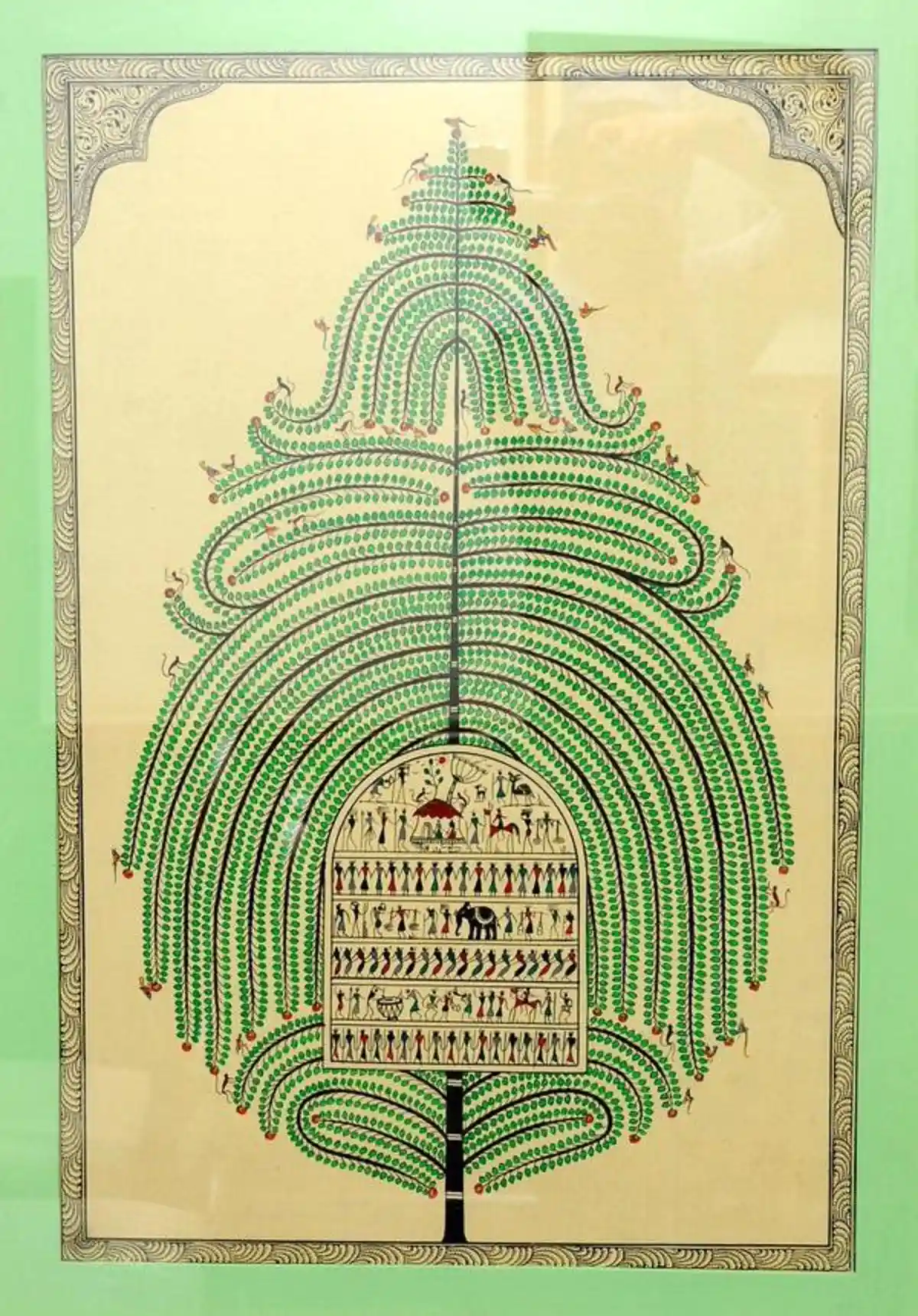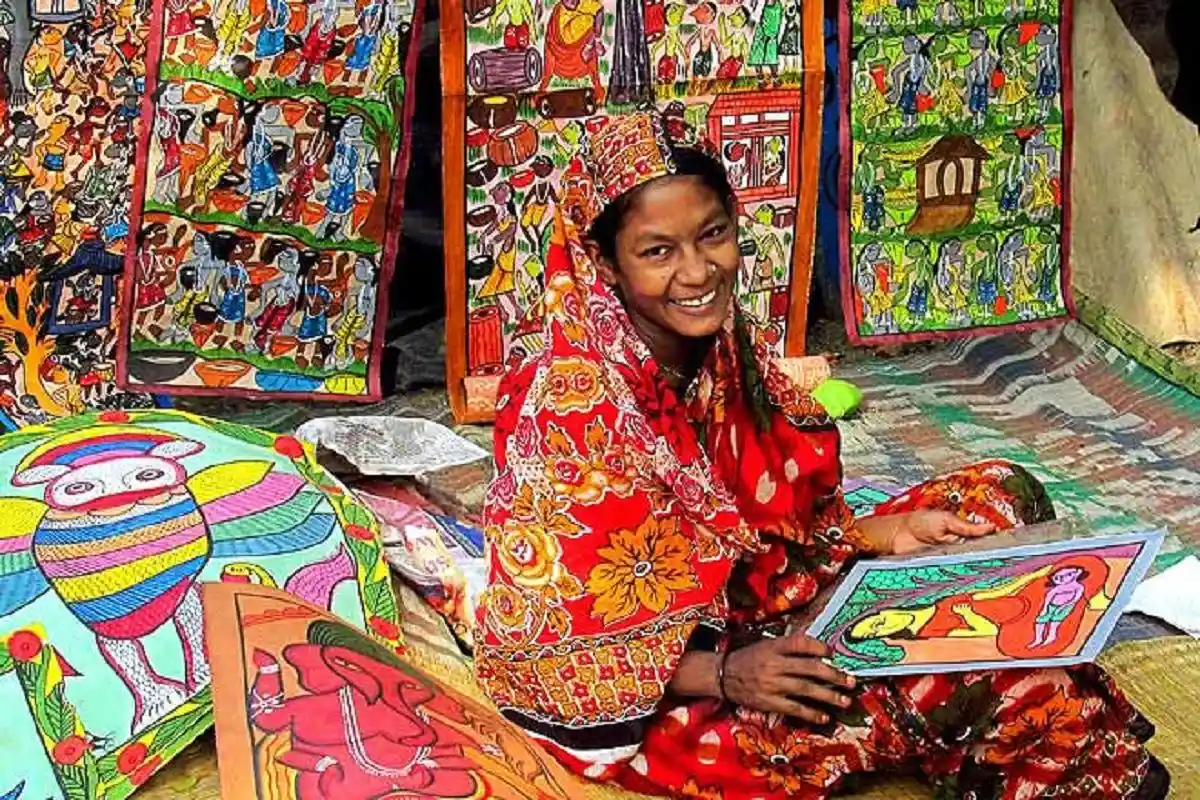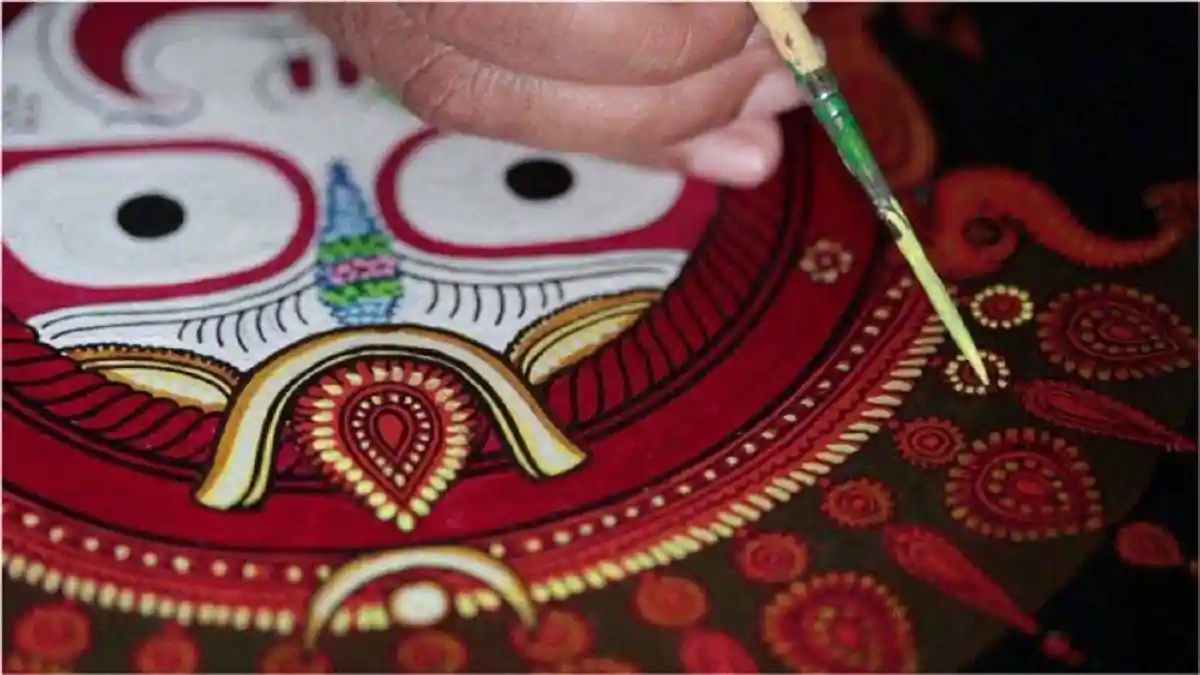Pattachitra: A Tale From Odisha
Born in Odisha, it continues to live on in India's first heritage village, Raghurajpur. Made with the skilled hands of the artisans, Pattachitra has every colour, every emotion, and every scene depicted in the best way possible. From scenes of Krishna and Radha to the most beloved god of Odisha, Lord Jagannatha, Pattachitra has a particular page dedicated to every Hindu deity. Let's explore Raghurajpur and find out more about the unique style of painting that has captured the heart of the entire country.

When Jagannatha adopts the face of Pattachitra; Image Source: Vajiram IAS
I remember my dad saying that whenever you visit Odisha, make sure that you also see the holy land of Lord Jagannatha, Puri. I had promised him that I would visit the temple and bring him the mahaprasad of Puri, famous worldwide. But neither did I get the chance to visit Puri, nor did I have the opportunity to feed mahaprasad to the person I loved the most. Though my dad is no more in this world, I always remember that ever-happy face of his and his advice, "Do whatever you wish to. Always listen to your heart."
Today I was finally travelling to Odisha upon Raina's constant insistence. We were on the plane. Raina was busy listening to some pop music on her headphones while I was busy searching up more about Odisha and some of its famous art forms. While scrolling through the endless pages on my laptop, I finally came across an art form called Pattachitra. Amazed at the beautiful contrast of colours and even more beautiful faces of Jagannatha, Krishna, Ganesha, and other Hindu deities, I finally decided that this trip of mine would be solely concentrated on finding and knowing more about Pattachitra and how it is made.
Suddenly, I felt a nudge on my right side. Upon turning, I found a middle-aged woman smiling subtly at me. I, too, smiled and folded my hands, saying namaskar to her. "May lord Jagannatha bless you, my child. I saw that you were trying to find out about Odisha's famous art form, Pattachitra. I think I can help you with that.", she said. By the time she had finished her line, Raina too was listening to her with rapt attention, with her headphones still on. Smiling gently, the woman said, "Have you girls heard of this famous heritage village named Raghurajpur?"
We nodded our heads, and Raina spoke, "Yes, I had heard of this village. In 2015, when Narendra Modi was on a diplomatic trip to France and Germany, he took a painting from this very village and presented it to the then French President, Francois Hollande."
For most of us, Pattachitra is like a family business. We are trying to keep the tradition alive just like our ancestors did back in the days of yore. The pioneer behind this art form was Maharana Jagannath Mahapatra. In earlier times, the artisans used to make masks out of paper mâché or dolls made up of materials like cow dung or mud. There are many other Pattachitra centres in Odisha, including Paralakhemundi, Chikiti, Dana Sahi, and Sonepur. Not only in Odisha, but Pattachitra is famous in several different places like West Bengal and some parts of Bangladesh too.", said Bhaskar, neatly painting the face of Buddha with his finely tipped brush.
"How are these Pattachitra paintings usually made? And how many days does it take to complete one artwork?" I asked with a curious expression on my face. "In Odisha, we practice mainly three forms: Pattachitra or paintings on clothes, Bhittichitra or paintings on walls, and Talapatrachitra or images on palm leaves. The painters are known as chitrakars. The home of a chitrakar is his art studio.
"How did Pattachitra originate?" asked Raina, swirling the steaming cup of tea in her hands. "The Pattachitra comes from two different words: Patta, meaning cloth, and Chitra meaning art. We could say that these are nothing but the art on clothes depicting the stories of Hindu deities. The art of Pattachitra in Odisha is closely related to the much-loved deity, Jagannatha, who is said to be an avatar of Lord Krishna. Thousands of devotees flock to Puri to witness the Snana Yatra or the "bathing procession." During the scorching months of May and June, all the three deities of Jagannatha temple, including Subhadra, Balabhadra, and Jagannatha, are bathed to help them get relief from the heat.
It is said that after taking a bath, all the three deities catch the fever for fifteen days called Anasar. The devotees cannot have the darshan of their beloved deities for fifteen days. From here originates the art of Pattachitra. Artisans of Odisha decided to make portraits of all the three deities so that the devotees could see them even when they are not in Puri.", completed Bhaskar, while taking out an incomplete painting of Buddha.
"Is Raghurajpur the only place in Odisha where Pattachitra is made?" I asked while carefully examining the unfinished Buddha painting. "The Pattachitra paintings originated from Raghurajpur. Inspired by Jagannatha Sanskriti, these paintings were initially created on wooden planks with natural pigments. Hundreds of artisans live in Raghurajpur, carrying on their predecessor's traditions. Tourists and buyers from all over the world flock to the village to buy some of the most beautiful handcrafted pieces of art to decorate their homes.
Bhaskar Maharana gave me a book titled Pata-Paintings of Orissa, which was published in the year 1984 and while I was on my way to yet another fascinating journey of art, I read it and came across a beautiful quote. I want to mention an illuminating quote by Dr M Krasa, a Czech scholar with a remarkable contribution to Indian studies:
"Strange is this world of the Orissa Paintings, a world in itself where every article and ornament keeps its unchanging shape, its place and importance, where every animal has its own stylized features, every personality its unerring marks of identification, defined by the ancient texts, religious myths and local tradition. It is a world of myths and gods, a world of folk imagination, the reflection of millions of Indian peasants, fishermen and craftsmen, their joys, their hardships, binding faith and exacting beauty. So the paintings speak the language of their creators, they give realistic expression, a clear symbol and humorous details. They are familiar to the eye, close to the heart, bringing joy, expressing life."
The board on which the artwork will be created is first treated with a combination of chalk and tamarind seed gum. The mixture is spread on the canvas using stones of two different textures. It offers the canvas a leathery surface on which the painters paint with vegetable, earth, and stone colours.
While the women prepare the mixture, which is to be applied on the canvas, fill the colours and give the final lacquer coating, the male members draw the initial outline and provide the final touch to the painting. One of the most exciting aspects of Pattachitra paintings is the colour obtained from natural materials.
For instance, white colour is obtained from seashells that are powdered, soaked and then heated. Placing an earthenware dish over the smoke of a burning candle also produces black pigment. Green leaves and greenish rocks are used to create the colour green. A stone called Hingula found in Odisha is used to prepare the red coloured pigment. Another stone called Harital is used to make the yellow-coloured pigment. Last but not least, the blue colour is obtained from a stone called Khandaneela.
These five colours form an integral part of Jagannatha's painting. Hasya or laughter is portrayed in white, Raudra or furious is represented in red, and Adbhuta or astonishment in yellow.", completed Bhaskar.
"It takes us about two days or ten man-hours to finish a painting. The time required for finishing a painting usually depends on the size of the painting and the intricacies or details required in it. Our fathers and grandfathers were not involved in bringing detailed and intricate work into the art form. However, nowadays, people are demanding intricate artworks on motifs of idols. The price of the artwork also depends on two factors: size and intricacy of the work.", said Bhaskar while showing us his hoard of paintings and other mural works.
"Yes. You're right. The painting that PM Narendra Modi presented to the French President Francois Hollande was made by a famous artist of Raghrajpur named Bhaskar Mahapatra. The painting, too, was made with an interesting concept in mind. Every year, we celebrate Rath Yatra at Puri. However, in 2014, we also celebrated Nabakalebara, celebrated every twelve years. This festival marks the birth and death of Lord Jagannatha. The painting made by Bhaskar, too, was based on this idea. He had named the painting "Tree of Life", and this painting stands in a library in Germany, depicting the rich culture and heritage of Odisha.", said the woman, with a proud smile on her face.
After an hour, when we exited the airport, the woman advised us to visit Raghurajpur if we wanted to know more about Pattachitra. We booked a cab and were finally on our way to Raghurajpur. When we reached the village, I was enthralled by its beauty. The community of more than 120 dwellings was set among coconut, palm, mango, and jackfruit trees. Every house was decorated attractively.
With mural paintings and Pattachitra art, the houses looked beautiful. People who lived here practised not only Pattachitra but also created conventional face masks, rock cultural icons, paper mache, statues, and wooden toys. The craft village was like a treasure trove in the middle of an endless ocean.
As we proceeded towards the village, we met an older woman who gave us the address of Bhaskar Mahapatra, the famous Pattachitra artist of Raghurajpur. As we came in front of Bhaskar's house, we saw him sitting on a cane cot, with a few brushes and an array of colours, wandering in his magical world of art. When he saw us, he warmly welcomed us into his home.
As I entered the small living room of his house, I saw a massive pile of scrolls stacked in one corner with various other art supplies. Colourful paper mâché masks adorned one of the walls. The other corner of the room was filled with modern artwork like painted glass bottles, wooden idols of Jagannatha, Balabhadra, and Subhadra, and a stock of palm leaf inscriptions and paintings.

A house filled with Pattachitra Paintings in Raghurajpur; Image Source: Flickr

The Tree of Life representing the Nabakalebara Festival; Image Source: eOdisha- WordPress

The colourful Pattachitra in West Bengal; Image Source: Medium

The village of Raghurajpur: A pioneer of Pattachitra Art; Image Source: Places to visit in Puri

The intricacy of Pattachitra; Image Source: Housenama


